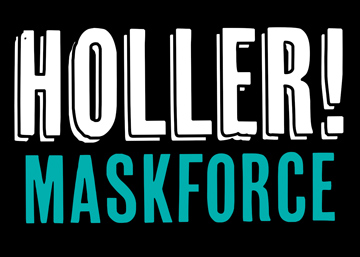Patterns
Before starting down the road of making masks for yourself and others. Please check out this great resource of best practices: https://maskfacts.org
All of our preferred patterns include a pocket so additional filtration can be added.
- Downloadable Holler! Mask Pattern (Can fit over N95 or other masks)
Pattern for sizes Medium and Large plus tutorial:
Pattern: https://hollermaskforce.org/HMF-MaskPatterns-Med-Large.pdf
Tutorial: https://hollermaskforce.org/HMF-tutorial.pdf
- S/M/L scalable pattern with tutorial: https://www.instructables.com/id/DIY-Cloth-Face-Mask/?fbclid=IwAR3n0ibvNsASIjKKVy3RkSLGW4Y1L4hPHHQnZoj70HEcPpCs1b5MJ3mDjQU.
- Rectangular mask tutorial, great for beginners and doesn’t require a printed pattern: https://www.youtube.com/watch?v=S9RWII2-5_4&feature=share&fbclid=IwAR2u6j4_qdY_8-xpL-pWfjVHgbX59pvul3AeRFeRmOPTzrbU_hg9T4Y0SQc
Materials
- 100% cotton is required for main and lining fabric
- Main: tight weave like quilting fabric, duck canvas or denim
- Lining: tight weave cotton like quilting fabric or cotton flannel (supposedly the filtration is even better w/ flannel but not recommended for small kids as it might be more difficult for them to breathe through.)
- Pro Tip: Masks will be washed and sterilized, so laundering, drying, and ironing fabric before making masks will prevent shrinkage.
- Straps
- ¼” elastic or elastic cord is easiest to use
- Fabric straps sewn into each corner work as well, and may hold up better to repeated laundering
- Pro Tip: If you have slightly thinner or wider elastic, you can adjust the width of the elastic casing on whichever pattern you are using to better fit what you have.
- Filter Materials (if available):
- Nonwoven, melt blown material is best. We are currently working on acquiring some but don’t yet have access to any. Let us know if you have any leads!
- Alternatives: vacuum bags (may be difficult to breathe through), coffee filters, other masks.
Disclaimer: These face masks are not medical grade or meant to replace the surgical face mask or N95. They are intended as a contingency option for those with no access to proper PPE or are running on a limited supply. Proper use of a surgical mask is still the best way to prevent virus infection.
